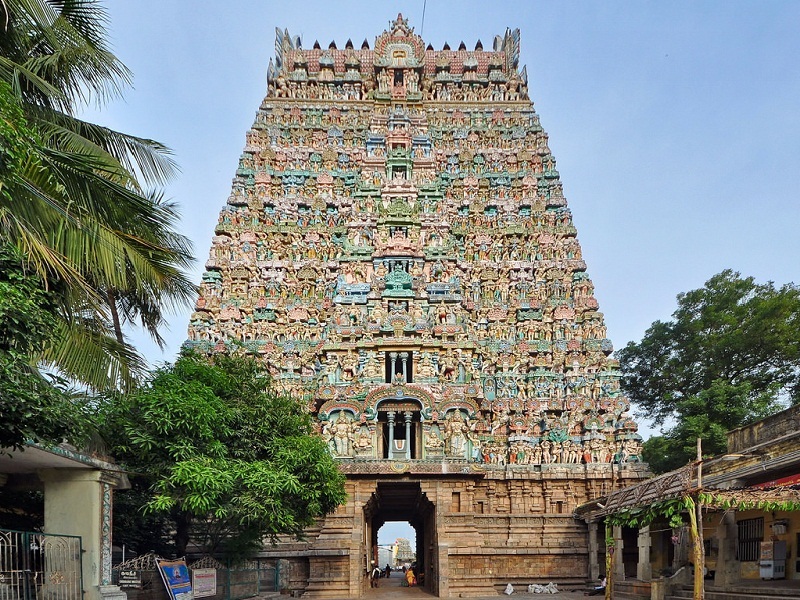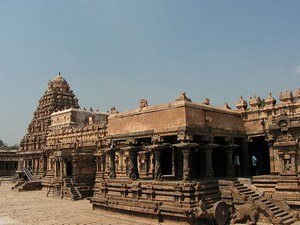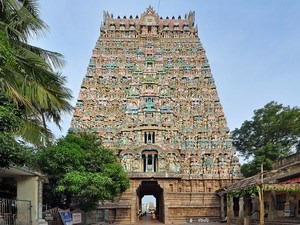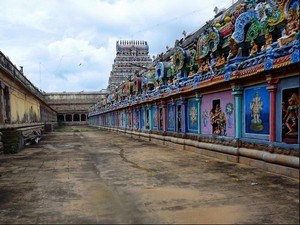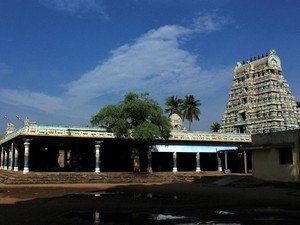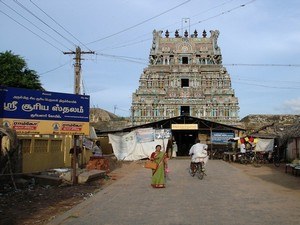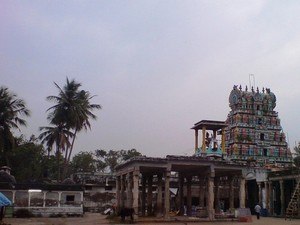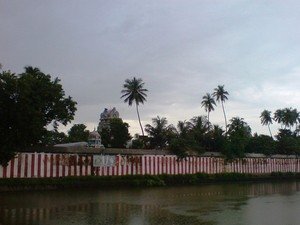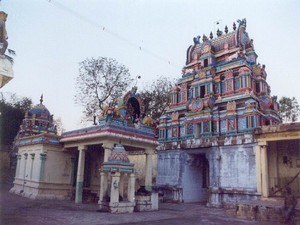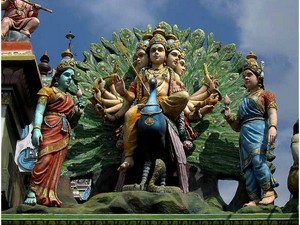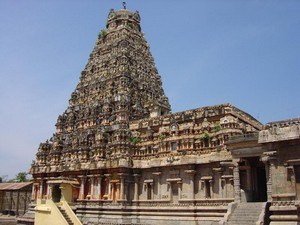Sarangapani Temple, Kumbakonam - Timings, Festivals, History, Darshan, Pooja Timings
Photo Credit: Flickr
 India | TamilNadu | Kumbakonam
India | TamilNadu | Kumbakonam
 #3 of 30 Places to Visit in Kumbakonam
#3 of 30 Places to Visit in Kumbakonam
 Distance (From Kumbakonam Railway Station): 2 Kms
Distance (From Kumbakonam Railway Station): 2 Kms
 Trip Duration (Including Travel): 30 Mins
Trip Duration (Including Travel): 30 Mins
 Place Location: Near Adi Kumbeswarar Temple
Place Location: Near Adi Kumbeswarar Temple
 Transportation Options: Walk/Trek
Transportation Options: Walk/Trek
 Travel Tips: None
Travel Tips: None
About Sarangapani Temple
At a distance of 2 km from Kumbakonam Railway Station, Sarangapani Temple is a Hindu temple situated near Adi Kumbeswarar Temple in Kumbakonam. Also known as Thirukudanthai, or Kumbakonam koyil, the temple is dedicated to Lord Vishnu. Here, the deity is holding a bow in the hand hence the name Sarangapani where Sarangam means bow and pani means hand. The Sarangapani Temple is also one of the Pancha Ranga Khestras located along the banks of the Kaveri River with the other four being Srirangapatnam, Srirangam, Appalarangam, and Vatarangam at Sirkazhi. It is one of the must include places in Kumbakonam pilgrimage packages.
The Sarangapani Temple is acknowledged as the sixth of the 108 Divya Desams dedicated to Lord Vishnu, celebrated in the Nalayira Divya Prabandham by the twelve poet saints known as Alvars. Additionally, it is esteemed as one of the Pancha Kshethram, where Goddess Lakshmi was born as Bhargavi, the daughter of Maharishi Bhrigu. The other four temples in the Pancha Kshethram include the Sundararaja Perumal Temple in Salem, the Oppiliappan Temple in Thirunageswaram, Nachiyar Koil, and the Venkateswara Temple in Tirumala.
History of Sarangapani Temple
The Sarangapani Temple dates back to the Pallava era; however, the existing edifice is linked to the Vikrama Chola period, beginning in 1121 AD. Its importance grew significantly during the reigns of the Vijayanagara and Nayaka dynasties from the 15th to the 17th centuries, which saw considerable expansion of the temple's structure. At that time, it was one of the three principal Vaishnava temples in Kumbakonam, alongside the more recent Ramaswamy Temple and the Chakrapani Temple. In the 17th century, during the Nayaka rule, a Vaishnava matha became affiliated with the temple. The temple is currently maintained and overseen by the Hindu Religious and Charitable Endowments Department of the Tamil Nadu Government.
Mythology of Sarangapani Temple
According to a legend, sage Hemarishi undertook rigorous penance on the banks of Potramari Tank, desiring to have Goddess Lakshmi as his daughter. Impressed by the sage's unwavering devotion, Lord Vishnu manifested before him in the form of Sarangapani and fulfilled his wish. Goddess Lakshmi emerged in between thousands of lotuses in the Potramarai Tank. She was named Komalavalli, meaning the one who appeared from lotuses. Subsequently, Lord Vishnu returned to earth in a chariot as Aravamudhan to persuade Goddess Lakshmi to accept his proposal of marriage. Upon her consent, they were wed.
Architecture of Sarangapani Temple
Sarangapani Temple stands as the largest Vishnu temple in Kumbakonam, holding immense religious importance and ranking just after the Srirangam Temple in Trichy. The temple features five prakaras and a sacred water tank known as Porthamarai Kulam. A notable highlight of the Sarangapani Temple is its main entrance, the rajagopuram, which rises to a height of 173 feet and consists of eleven tiers. This structure is the tallest temple tower in Kumbakonam and ranks as the third tallest gopuram among the Divya Desams, following Srirangam (236 feet) and Srivilliputhur (192 feet).
The temple's central shrine is designed in the shape of a chariot, drawn by horses and elephants, with openings on both sides depicting the descent of Sarangapani from the heavens. Access to the sanctum is through a hall supported by 100 pillars. The idol of Sri Sarangapani, also referred to as Aarvamudhan, Abayaryaapthamiruthan, and Utthanasayi, is depicted in a pallikonda posture, resting his head on his right hand. Within the sanctum, one can also find images of sage Hemarishi, Lakshmi, and various festival representations. The sanctum has two stepped entrances, known as Utharayana Vaasal and Dhakshanayana Vaasal, each open for six months of the year.
The shrine dedicated to Komalavalli Thayar is situated in the northern section of the temple, parallel to the main sanctum. At the center of the Potramarai tank lies the Hemarishi Mandap. The temple walls are adorned with 108 karanas of Bharatanatyam, similar to the sculptures found in the Brihadeeswarar Temple in Thanjavur and the Nataraja Temple in Chidambaram. Additionally, two intricately carved wooden processional chariots are positioned outside the rajagopuram.
Festivals of Sarangapani Temple
The Sarangapani Temple in Kumbakonam celebrates several festivals throughout the year, including the prominent Chithirai Utsav (March-April), Vaikasi Vasantha Utsav (May-June), and Masi Float Festival (February-March). Among these, Chithirai Chariot festival is the most famous festival of the temple when the twin temple chariots are taken in procession around the temple during festivals. Brahmotsavam, spring festival and Navaratri are the other important festivals of this temple.
Dress Code & Other Restrictions of Sarangapani Temple
When planning a visit to the Sarangapani Temple in Kumbakonam, it is recommended to adhere to modest clothing that covers your upper arms and legs as a sign of respect. Men are encouraged to wear a dhoti or pajama paired with an upper garment, as well as formal trousers and shirts. Women may opt for a saree, half saree, or churidhars. It is advisable to refrain from wearing contemporary attire such as mini-skirts, low-waist jeans, shorts, and sleeveless tops while on the temple grounds.
Non-Hindus are welcome to explore the temple complex and appreciate its architectural beauty; however, access to the sanctum sanctorum may be restricted.
Sarangapani Temple Timings
Monday: 7 AM - 12:30 PM & 4:30 PM - 9 PM
Tuesday: 7 AM - 12:30 PM & 4:30 PM - 9 PM
Wednesday: 7 AM - 12:30 PM & 4:30 PM - 9 PM
Thursday: 7 AM - 12:30 PM & 4:30 PM - 9 PM
Friday: 7 AM - 12:30 PM & 4:30 PM - 9 PM
Saturday: 7 AM - 12:30 PM & 4:30 PM - 9 PM
Sunday: 7 AM - 12:30 PM & 4:30 PM - 9 PM
Sarangapani Temple Entry Fee
General Entry is Free
Special Darshan available for Rs. 10
Best Time to Visit Sarangapani Temple
The ideal period to visit Sarangapani Temple is between October and March, while the peak season is from November to February due to the consistently pleasant weather. During these months, several major festivals are also celebrated, including the notable Chithirai Utsav (March-April), Masi Float Festival (February-March), and Navratri, providing a unique chance to experience the vibrant atmosphere of the temple, which attracts thousands of devotees. It is recommended to refrain from visiting during the peak summer months of April to June, as the temperatures can become quite high, making outdoor activities more challenging.
How to Reach Sarangapani Temple
Trichy Airport serves as the closest airport, located approximately 95 kilometers from Kumbakonam. The Kumbakonam Railway Station offers extensive train connectivity to various cities, including Chennai, Rameswaram, Kanyakumari, Pondicherry, Mysore, Mayiladuthurai, Thanjavur, Trichy, Bhubaneswar, Madurai, Coimbatore, Tirupati, Bangalore, and Thirunelveli. Additionally, bus services are available to Kumbakonam from all regions of Tamil Nadu. To reach the Sarangapani Temple, one can take a bus or hire an auto-rickshaw or cab from anywhere within Kumbakonam.



